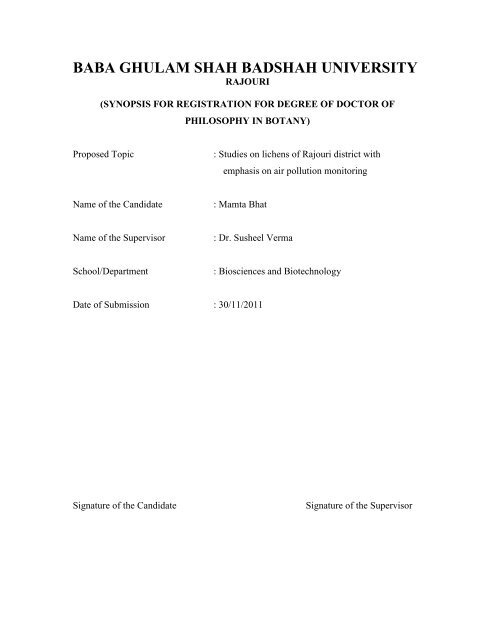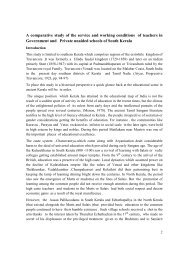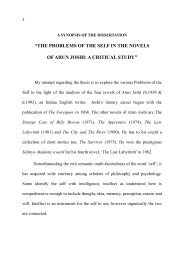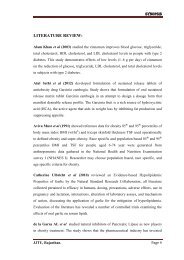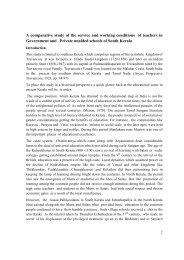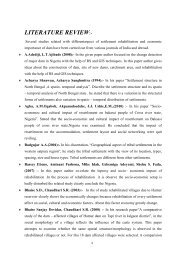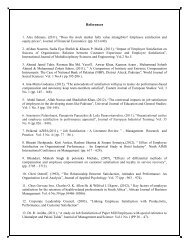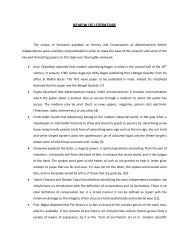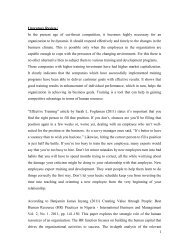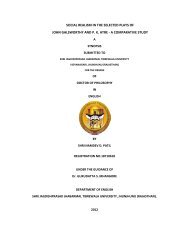mamta synopsis.pdf
mamta synopsis.pdf
mamta synopsis.pdf
Create successful ePaper yourself
Turn your PDF publications into a flip-book with our unique Google optimized e-Paper software.
BABA GHULAM SHAH BADSHAH UNIVERSITY<br />
RAJOURI<br />
(SYNOPSIS FOR REGISTRATION FOR DEGREE OF DOCTOR OF<br />
PHILOSOPHY IN BOTANY)<br />
Proposed Topic : Studies on lichens of Rajouri district with<br />
Name of the Candidate : Mamta Bhat<br />
Name of the Supervisor : Dr. Susheel Verma<br />
emphasis on air pollution monitoring<br />
School/Department : Biosciences and Biotechnology<br />
Date of Submission : 30/11/2011<br />
Signature of the Candidate Signature of the Supervisor
SYNOPSIS FOR REGISTRATION FOR DEGREE OF DOCTOR OF<br />
PHILOSOPHY IN BOTANY<br />
Proposed title: Studies on lichens of Rajouri district with emphasis on air<br />
pollution monitoring.<br />
Background and justification:<br />
Rajouri, the border district of Jammu and Kashmir state, with an area of 2630 km 2<br />
partly comes under Pir Panjal mountain range. It lies between 70 – 74⁰4' East<br />
longitude and 32⁰58' – 33⁰35' North latitude. A wide diversity of vegetation from<br />
subtropical to alpine type exists in the region. Although some studies have been<br />
undertaken to document the information on higher plants of the district (Rashid, et<br />
al, 2008; Pant and Verma, 2009; Sarver, et al, 2009; Pant, 2011), lower groups of<br />
organisms, despite their pivotal role in stabilizing the ecosystems, have got least<br />
attention till date. As such no information is available on their number, diversity in<br />
the habit, habitat and their potential as useful organisms. The present study aims to<br />
fill the gap by collecting information on one such significant group i.e. lichens.<br />
Lichens are the most successful symbiotic organisms in nature, dominating 8% or<br />
more of the earth’s terrestrial area (Ahmadjian, 1995). These are among the most<br />
significant indicators of air pollution and ecosystem health (Upreti and Pandev,<br />
1994; Wolseley, et al, 1994; Upreti, 1995; Sloof, 1995; Mistry, 1998; Vokou, et<br />
al, 1999). Economically lichens are very significant, being used in traditional<br />
medicines (Gonzalez – Tejero, et al, 1995; Upreti, 1994; Negi and Kareem, 1996),<br />
as dyes (Casselman, 2001), as staple diet of the Alaskan reindeer (Skunke, 1969)<br />
and Himalayan musk deer (Negi, 1996). India is a rich centre of lichen diversity,<br />
contributing nearly 15% of the 13,500 species of lichens recorded in the world<br />
(Groombridge, 1992). Despite this, there is a poor record of lichen explorations<br />
and many areas, especially mountains and forest canopies remain unexplored
(Negi and Gadgil, 1996; Negi and Upreti, 2000). In India, Jammu and Kashmir is<br />
one of the lichen rich regions, oftenly known as ‘Hot Spot’ of lichen diversity<br />
(Sheikh, et al 2006). In Jammu and Kashmir too, no earlier data of lichen<br />
explorations is available for Rajouri, Poonch, Kathua and Kupwara (Sheikh, et al,<br />
2006). There is need to generate baseline data and gather information on them in<br />
this part of country.<br />
After independence the region has undergone lot of changes due to urbanization,<br />
infrastructural development, construction of roads in far flung areas and<br />
improvement in the transport facility there by increasing the traffic density even in<br />
the distant townships. Consequently, one of the serious environmental threat in<br />
this region, as in rest of the world, is the increasing concentration of pollutants in<br />
the air and there is a need of better indicator systems to monitor air pollution.<br />
Lichens are being increasingly used as air quality biomonitors (Bartoli, et al, 1997;<br />
Malysheva, 1998; Ockenden, et al, 1998). They have several advantages over<br />
electronic monitors which are expensive and their use and maintenance are not<br />
simple. In addition electronic monitors are limited to few elements or chemical<br />
compounds and have no intrinsic relationship with the biological effects of<br />
contaminants (Rodrigo, et al, 1999). In India, however, only a few reports<br />
regarding use of lichens in air pollution monitoring are available (Das, 1985;<br />
Dubey, 1999).The study planned will include the effect of various pollutants on<br />
lichens in the Rajouri district and physiological responses of lichens to pollution.<br />
Objectives of the study:<br />
Following are the objectives of the present study to be undertaken in Rajouri:<br />
1. Collection and identification of the lichens from diverse habitats of the<br />
district.
2. Ecological assessment of lichen diversity.<br />
3. Comparison of lichen types with respect to air pollution levels.<br />
4. Determination of the tolerant and sensitive lichen species.<br />
5. Metal estimation including heavy metals in different lichen species<br />
collected from the natural habitats and after transplantation.<br />
6. Ethno botanical uses of the lichens will also be documented.<br />
Methodology<br />
1. Taxonomic studies: Extensive surveys and collection trips shall be carried<br />
out for exploration of lichens of the region. Taxonomic details of the<br />
lichens will be worked out following the methodology proposed by<br />
Awasthi (1988, 1991, 2000) and the lichen chemicals will be identified<br />
following Walker and James (1980).<br />
2. Ecological studies:<br />
a. Ecological parameters such as number, density, frequency and abundance<br />
of the lichens in the field will be studied. These parameters will be used to<br />
calculate the Shanon Wiener’s diversity index (Shanon and Wiener, 1963).<br />
For this purpose, quadrats of 1sq. m will be laid and lichens as well as the<br />
substrate on which they grow will be carefully recorded. Data generated<br />
will be analysed statistically. Data thus collected will provide an account of<br />
the distribution pattern of lichens which will be helpful in preparing the<br />
lichen map of the region.<br />
b. In case of corticolous lichens, bark pH will also be measured using a pH<br />
meter after soaking bark extract in distilled water for 1 hour at 80 °C. Thus<br />
pH of the host tree suitable for lichen growth will be determined.<br />
3. Grid plotting: For determining the impact of air pollution on lichens grid<br />
plotting will be done. Each site will be divided into plots of 1 sq. km and
the number of species as well as their distance from source of pollution will<br />
be recorded (Saxena, et al, 2007).<br />
4. Metal estimation: For metal estimation of lichen species, the collected<br />
species, removed from the substratum, will be oven dried at 90°C and<br />
subjected to acid digestion in the mixture of HNO3 and HClO4 (v/v 9:1)<br />
until appearance of colourless solution followed by its filtering using<br />
Whatman’s filter paper No. 42 and dilution to 25ml with distilled water.<br />
Metal content will be analyzed using Atomic Absorption<br />
Spectrophotometer following Saxena, et al, 2007.<br />
5. Lichen Transplant: Sampling and measuring contaminants within the<br />
thallus is one of the ways to use lichens as air pollution monitor. For<br />
monitoring metal levels in areas devoid of lichen growth, transplant<br />
technique will be used. Different sites will be selected for transplanting<br />
lichens in the Rajouri district. Hyperphyscia adglutinata (Floerke) Mayrh<br />
and Poelt a common foliose lichen, collected from areas far away from any<br />
local source of atmospheric pollution will be used for the study. Thalli of<br />
similar sizes along with the substrate will be glued to a cardboard of 20×20<br />
cm size and then transplanted at a pole at the selected site for exposure. The<br />
duration of exposure will be 18 days (Bajpai, et al, 2004) to 16 weeks<br />
(Bačkor, et al, 2003) for each transplant. Afterwards, the samples will be<br />
collected from the monitoring sites and lichens will be removed from the<br />
bark for heavy metal estimation.<br />
6. Ethnobotanical studies: Semi – structured, open ended questionnaire will<br />
be prepared for generating ethnobotanical information.<br />
Possible outcomes:<br />
The possible outcomes of this work will be:<br />
a) a baseline data on taxonomy of lichens of the region will be created.<br />
b) an account of the lichen diversity of the study area will be documented.
c) records on the status of air pollution in Rajouri district will be compiled.<br />
d) best pollution indicator species will be identified and the species<br />
accumulating highest concentration of heavy metals will be determined.<br />
They will then be recommended for determining air pollution concentration<br />
at other places.<br />
e) a lichen garden/sanctuary will be established in the Pir Panjal Biodiversity<br />
References<br />
Park, BGSBU for their conservation.<br />
1. Ahmadjian, V. 1995. Lichens are more important than you think. Biosc. 45:<br />
124.<br />
2. Awasthi, D. D. 1988. A key to the macrolichens of India and Nepal. J. Hatt.<br />
Bot. Lab. No. 65: 207 – 303.<br />
3. Awasthi, D. D. 1991. A key to the microlichens of India, Nepal and Sri<br />
Lanka. Biblioth. Lichnol. 40: 1 – 337.<br />
4. Awasthi, D. D. 2000. Lichenology in Indian subcontinent. Bishen Singh<br />
Mahendra Pal Singh, Dehradun, India.<br />
5. Bačkor, M., Paulíková, K., Geralská, A. and Davidson, R. 2003.<br />
Monitoring of air pollution in Košice (Eastern Slovakia) using Lichens. Pol.<br />
J. of Env. Stud. 12: 141 – 150.<br />
6. Bajpai, R., Upreti, D. K. and Mishra, S. K. 2004. Pollution monitoring with<br />
the help of lichen transplant technique at some residential sites of Lucknow<br />
city, Uttar Pradesh. J. of Env. Bio. 25: 191 – 195.<br />
7. Bartoli, A., Cardarelli, C., Achilli, M., Campanella, L., Ravera, S. and<br />
Massari, G. 1997. Quality assessment of Maremma Laziale area using<br />
epiphytic lichens. Allio. 35: 69 – 85.<br />
8. Casselman, K. D. 2001. Lichen dyes: The new source book. Dover<br />
Publications, NewYork.
9. Das, T. M. 1985. Lower and higher plant groups as indicators of air<br />
pollution. Symp. Biomon. St. Environ. 1: 232 – 234.<br />
10. Dubey, A. N., Pandey, V., Upreti, D. K. and Singh, J. 1999. Accumulation<br />
of lead growing in and around Faizabad, U.P. India. J. of Env. Bio. 20: 223<br />
– 225.<br />
11. Gonzalez – Tejero, M. R., Martinej – Lirola, M. J., Casares – Porcel, M.<br />
and Molero – Mesa, J. 1995. Three lichens used in popular medicine in<br />
Eastern Andalucia (Spain). Econ. Bot. 49: 96 – 98.<br />
12. Groombridge, B. 1992. Global biodiversity: Status of earth’s living<br />
resources. Chapman and Hall, London.<br />
13. Malysheva, N. V. 1998. Lichens of St. Petersburg.3. The influence of town<br />
environment and lichen indication of atmospheric pollution. Bot. Zh. St.<br />
Petersburg. 83: 39 – 45.<br />
14. Mistry, J. 1998. A preliminary lichen – fire history key for the Cerrado of<br />
the Distrito Federal, Central Brazil. J. Biogeogr. 25: 443 – 452.<br />
15. Negi, H. R. 1996. Usnea longissima – the winter staple food of Musk deer ;<br />
a case study from Musk deer breeding center, Kanchulakharak in Garhwal<br />
Himalaya. Tiger paper. 23: 30 – 32.<br />
16. Negi, H. R. and Gadgil, M. 1996. Patterns of distribution of macrolichens<br />
in Western parts of Nanda Devi Biosphere Reserve. Curr. Sci. 71: 568 –<br />
575.<br />
17. Negi, H. R. and Kareem, A. 1996. Lichens: the unsung heroes. Amruth 1: 3<br />
– 6.<br />
18. Negi, H. R. and Upreti, D. K. 2000. Species diversity and relative<br />
abundance of lichens in Rumbak catchment of Hemis National Park in<br />
Ladakh. Curr. Sci. 78: 1105 – 1112.<br />
19. Ockenden, W. A., Steinnes, E., Parker, C. and Jones, K. C. 1998.<br />
Observations on persistent organic pollutants: Implications for their use as
passive air samplers and for pop CYCLING. Envir. Sci. Technol. 32: 2721<br />
– 2726.<br />
20. Pant, S. 2011. Buxus wallichiana L. (A multipurpose Himalayan tree in<br />
peril). Inter. J. of Bio. and Conser. 3:175 – 177.<br />
21. Pant, S. and Verma, S. 2009. Diversity and economic importance of<br />
agroforestry species in Dhanore region of Rajouri district, Jammu and<br />
Kashmir. Indian J. of For. 32: 401-405.<br />
22. Rashid, A., Anand, V. K. and Serwar J. 2008. Less known wild edible<br />
plants used by the Gujjar tribe of district Rajouri, Jammu and Kashmir<br />
State. International J. of Bot. 4: 219 – 224.<br />
23. Rodrigo, A., Avila, A. and Gomez – Bolea, A. 1999. Trace metal contents<br />
in Parmelia caperata (L.) Ach. Compared to bulk deposition, through fall<br />
and leafwash fluxes in two holm oak forests in Montseny. (NE Spain).<br />
Atmos. Envir. 33: 359 – 367.<br />
24. Sarver, J., Kumar, S., Khan, M., Ara, M. and Anand, V. K. 2009.<br />
Diversity, distribution and utilization pattern of economically important<br />
woody plants associated with agro – forestry in district Rajouri, Jammu and<br />
Kashmir (Northwest Himalaya). Ethnobot. Leafl. 13: 801-09.<br />
25. Saxena, S., Upreti, D. K., Sharma, N. 2007. Heavy metal accumulation in<br />
lichens growing in north side of Lucknow city, India. J. Environ. Biol. 28:<br />
49 – 51.<br />
26. Shanon, C. E. and Wiener, W. 1963. The mathematical theory of<br />
communication. University of illinois p ress, Urbana.<br />
27. Sheikh, M. A., Upreti, D. K. and Raina, A. K. 2006. Lichen diversity in<br />
Jammu and Kashmir, India. Geophyt. 36: 69 – 85.<br />
28. Skunke, F. 1969. Reindeer ecology and management in Sweden; Univ.<br />
Alaska Biol. Pap. 8: 1 – 82.<br />
29. Sloof, J. E. 1995. Lichens as quantitative biomonitors for atmospheric trace<br />
– element deposition: using transplants; Atmos. Environ. 29: 11 – 20.
30. Upreti, D. K. 1994. Lichens: the great benefactors; Appl. Bot. Abst. 14: 164<br />
– 175.<br />
31. Upreti, D. K. 1995. Loss of diversity in Indian lichen flora; Environ.<br />
Conser. 22: 362 – 363.<br />
32. Upreti, D. K. and Pandev, V. 1994. Heavy metals of Antarctic lichens: 1.<br />
Umbilicaria. Feddes Repert. 105: 197 – 199.<br />
33. Vokou, D., Pirintsos, S. A. and Loppi, S. 1999. Lichens as bioindicators of<br />
temporal variation in air quality around Thessaloniki, Northern Greece.<br />
Ecol. Res. 14: 89 – 96.<br />
34. Walker, F. J. and James, P. W. 1980. A revised guide to microchemical<br />
techniques for the identification of lichen products. Brit. Lich. Soc.<br />
Bulletin. 50: 13 – 29.<br />
35. Wolseley, P. A., Moncrieff, C. and Aguirre - Hudson, B. 1994. Lichens as<br />
indicators of environmental stability and change in the tropical forests of<br />
Thailand. Global Ecol. Biogeogr. L.


